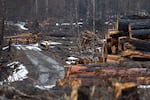
Logged areas in Breitenbush, March 5, 2021. The area was destroyed by the Beachie Creek and Lionshead fires in 2020.
Kristyna Wentz-Graff / OPB
The Bureau of Land Management has agreed to reverse a rule put in place during the Donald Trump presidency that allowed the agency to log large areas of forests after a wildfire without first doing an environmental review.
The 2020 rules increased the maximum area for “categorical exclusions” from 250 to 3,000 acres. These exclusions allowed the agency to approve logging projects without detailed environmental review, the argument being the projects would have minimal environmental impacts. A year ago, environmental groups sued the BLM over these rule changes.
Forest managers often approve logging projects in recently burned areas to salvage trees that could still be used as lumber.
The conservation groups argued the agency didn’t provide enough evidence as to why they expanded the excludable area. The lawsuit also argued post-fire logging without environmental review can be damaging to wildlife, including threatened species such as the northern spotted owl. The plaintiffs included Cascadia Wildlands, Klamath-Siskiyou Wildlands Center, Oregon Wild, Soda Mountain Wilderness Council and Willamette Riverkeeper.
Related: Owl habitat cuts by Trump appointees used ‘faulty’ science
“Ground-based logging and road building is really harmful to recently burned watersheds, which are pretty sensitive,” said Susan Jane Brown, wildlands program director for the Western Environmental Law Center.
Brown said in a post-fire forest, the remaining trees and plants help to prevent erosion, and keep sediment from washing into nearby waterways. She said environmental reviews show the impacts of human intervention on recently burned areas.
“So if you are proposing to do post-fire logging, it makes sense to take a hard look at the environmental consequences of that action and propose that kind of appropriate mitigation and alternatives,” she said.
Brown doesn’t say the BLM should never log in post-fire landscapes, but she said the agency should conduct a thorough environmental review to look at possible impacts, and identify ways to mitigate them.
The BLM already paused logging under the 2020 rules last summer. And according to the new agreement made with conservation groups, they’ll remove the previous language from the books in the next several years.
The agency will revert to its old guidance on post-fire logging, and projects larger than 250 acres will again require detailed environmental review.